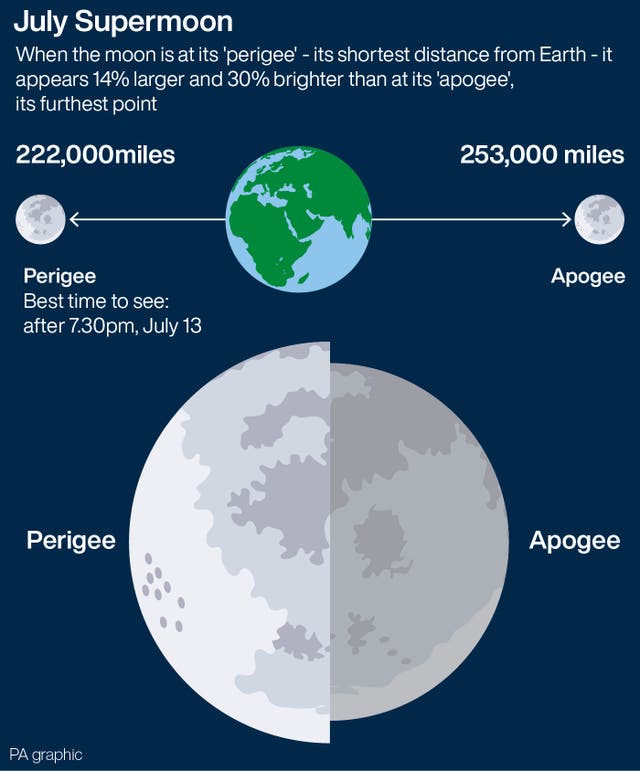Bigger and brighter supermoon to delight stargazers across the UK
July’s full moon is known as the Buck Moon because male deer shed and regrow their antlers around this time of year.
Stargazers across the UK are set to catch a glimpse of a bigger and brighter supermoon on Wednesday night.
July’s full moon is known as the Buck Moon because male deer shed and regrow their antlers around this time of year.
The name came from a Native American system which uses the different months’ full moons as a calendar to keep track of the seasons, said Anna Ross, a planetarium astronomer at Royal Museums Greenwich, in south-east London.
She said: “The best time to view this supermoon will be any time during the night of the 13th July, when the moon will rise in the east just after sunset, and set in the west a little before sunrise.

“There is no particular location you need to be to observe this event as this is a bright full moon. As long as the night is clear of clouds it will be easy to spot whether you are in a light-polluted city or a dark area of countryside.”
She said a supermoon is the result of a full moon occurring when it is near its closest point to the Earth in its orbit.
This can happen because the moon orbits the Earth on an elliptical path, rather than a circular one, she said.
Ms Ross added the Buck Moon will be the biggest and brightest supermoon of the year as it represents the moon arriving at its closest point to the Earth for 2022.
She said: “As a supermoon means that the moon is a little closer to us, it will appear slightly bigger in the sky.
“The apparent difference between the size of the full moon at its closest and farthest points is only around 14% and, although if you were on the moon its brightness wouldn’t change, being that bit closer, it also overall appears to be around 30% brighter to us here on Earth.
“The average distance of the moon from the Earth is 384,400km, but the Moon will reach its closest point this lunar month on the 13th July at 09:08, when it will be 357,264 km away.
“The exact moment of the full moon closest to this point is also on the 13th July, but at 19:37.
“This supermoon can be referred to as a Super Buck Moon.”
She says there is no formal limit to how close the full moon needs to be to the Earth to count as a supermoon.
The Royal Astronomical Society’s deputy executive director Dr Robert Massey “there is a lot of these” supermoons, but added: “The moon is a beautiful object – it is a fantastic thing, go out and look at it and enjoy the view.”
On Wednesday, the moonrise time from London is 9.48pm, it is 10.35pm in Edinburgh and 9.24pm in Plymouth, he said.
He added: “So that’s when you should start looking but to see it then of course you need a perfect horizon, so you need to be looking out over a very flat landscape or the sea.”
The Press Association
Latest posts by The Press Association (see all)
- 3 easy Mary Berry recipes to make this season - November 22, 2024
- In Pictures: Party stalwart kept New Labour in touch with traditional supporters - November 21, 2024
- 6 easy indoor exercises to try this winter – and why they are good for you - November 19, 2024
- Martin Clunes: I can’t afford to retire – I’ve got too many horses - November 19, 2024
- How to avoid plant losses, flowering disappointments and container catastrophes - November 17, 2024





















